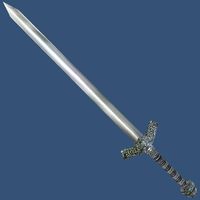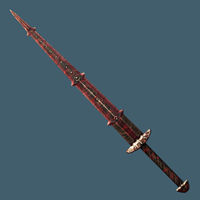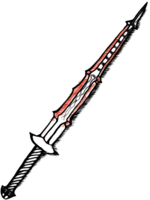Lore:Bloodskal Blade
The Bloodskal Blade (also known simply as Bloodskal) is an ancient Nordic artifact. In appearance it is an enchanted silver sword, either a long blade or a greatsword, sometimes decorated with red markings. It has the power to either cause magical frost damage to those that it strikes, or release a ribbon of mystical energy, a red energy blast which can hit an out-of-reach target.
The blade was created by the Bloodskal clan, a clan of Nords on Solstheim. It came to rest in Bloodskal Barrow, guarded by draugr. The energy blasts released by the blade were necessary to open a strange door within the ruins.
History[edit]
In 3E 427, the sword was discovered by the Nerevarine, on an altar near the entrance to the barrow. The Nerevarine took the sword, which summoned several undead skeleton and draugr guardians.[1]
By 4E 10, the artifact had returned to the ruins of Bloodskal Barrow. It was placed on a pedestal, in a large chamber behind the door which required the sword to open. That year, the East Empire Company broke through into the ruins from the Raven Rock ebony mine. Gratian Caerellius and his assistant Millius were tasked with exploring the ruins. Gratian discovered the sword, but removing it from its pedestal awoke a horde of draugr. The two adventurers died from their wounds, and the EEC sealed the ruins, claiming that Gratian had died in a tunnel collapse.[2]
In 4E 201, Gratian's great-grandson Crescius Caerellius uncovered old documents belonging to his ancestor, which affirmed his suspicions over the cause of Gratian's death. An old man, Crescius was unable to venture into the mines; instead, he enlisted the help of the Last Dragonborn, who then unsealed the entrance to the ruins and discovered Gratian's body, along with the Bloodskal Blade. The Dragonborn used the blade to open the door in the ruins and escape the barrow, and related the discovery of Gratian's remains to Crescius.[3]
Gallery[edit]
Notes[edit]
- The Bloodskal Blade appeared in the Bloodmoon expansion for TES III: Morrowind and the Dragonborn add-on for TES V: Skyrim.
- There is no known association between the blade and Blodskaal, a title awarded by the Skaal to outsiders who they have accepted as kin.
See Also[edit]
For game-specific information, see the Bloodmoon entry and the Dragonborn article.
References[edit]
- ^ Events of Morrowind: Bloodmoon
- ^ Gratian's Journal — Gratian Caerellius
- ^ Events of Skyrim: Dragonborn
| |||||||||||||||||||||||||


